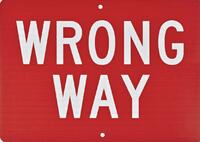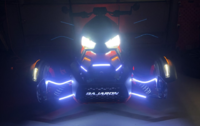|
-
Active Member

 Question regarding SM5 transmission Question regarding SM5 transmission
Iíve searched but canít really find what Iím looking for.
A friend just picked up his 1st Spyder yesterday after 50 years on 2 wheels.
Itís a 2013 ST-S SM5
I know about keeping up the revs while upshifting and that doesnít seem to be as issue with his bike (I did the test ride on it).
Hereís the question:
Letís say I shift into 3rd gear at 5,000 rpmís and then have to slow down. Will the centrifugal clutch stay engaged if I slow down as long as I donít downshift??
I hope I explained this properly.
Looking forward to the responses and thanks.
Greg
Greg
2015 RT Limited (White)
-

It will stay engaged until either you manually downshift or you get slow enough that it automatically downshifts.
-
Active Member


I kind of figured it would stay engaged.
This is a manual transmission so it won’t automatically downshift
Greg
2015 RT Limited (White)
-
SpyderLovers Sponsor


 Originally Posted by Wrongway

I kind of figured it would stay engaged.
This is a manual transmission so it won’t automatically downshift
Only the SE5 will automatically downshift. The SM5 is a true manual transmission. It doesn't have a centrifugal clutch. It just has a clutch. You can kill the motor by slowing to a speed below idle RPM, just like with any other manual transmission.
It isn't nearly as critical to keep RPM up with the manual transmission as it is with the SE5, electric shift transmission. Though it is harder on the motor to try and accelerate from too low an RPM. The clutch doesn't care.
Shop Ph: 423-609-7588 (M-F, 8-5, Eastern Time)
Only SLOW people have to leave on time...


-
Active Member


 Originally Posted by BajaRon

Only the SE5 will automatically downshift. The SM5 is a true manual transmission. It doesn't have a centrifugal clutch. It just has a clutch. You can kill the motor by slowing to a speed below idle RPM, just like with any other manual transmission.
It isn't nearly as critical to keep RPM up with the manual transmission as it is with the SE5, electric shift transmission. Though it is harder on the motor to try and accelerate from too low an RPM. The clutch doesn't care.
So if I understand this correctly, only the SE5 has the centrifugal clutch??
That certainly will make the SM5 more manageable to ride in my opinion.
Last edited by Peter Aawen; 09-08-2022 at 11:04 PM.
Reason: Put Quote above reply for ease of Reading/understanding & match Forum usage!
Greg
2015 RT Limited (White)
-
SpyderLovers Sponsor


 Originally Posted by Wrongway

So if I understand this correctly, only the SE5 has the centrifugal clutch??
That certainly will make the SM5 more manageable to ride in my opinion.
The SE5 is a completely different animal as far as the clutch goes. The SM5 is just a simple, straight forward, multi-plate wet clutch. The SE5 has this same clutch pack configuration, but shifting is accomplished in a completely different manner. Running at too low an RPM can damage the SE5 clutch. Not so the SM5.
It is, however, a good idea to keep the RPM's up for the engine's sake on the SM5.
Shop Ph: 423-609-7588 (M-F, 8-5, Eastern Time)
Only SLOW people have to leave on time...


-
Active Member


 Originally Posted by BajaRon

The SE5 is a completely different animal as far as the clutch goes. The SM5 is just a simple, straight forward, multi-plate wet clutch. The SE5 has this same clutch pack configuration, but shifting is accomplished in a completely different manner. Running at too low an RPM can damage the SE5 clutch. Not so the SM5.
It is, however, a good idea to keep the RPM's up for the engine's sake on the SM5.
Got it. Thanks very much for clearing this up for me. It’s greatly appreciated.
Last edited by Peter Aawen; 09-08-2022 at 11:05 PM.
Reason: Quote above reply...
Greg
2015 RT Limited (White)
-
Very Active Member


 Originally Posted by BajaRon

The SE5 is a completely different animal as far as the clutch goes. The SM5 is just a simple, straight forward, multi-plate wet clutch. The SE5 has this same clutch pack configuration, but shifting is accomplished in a completely different manner. Running at too low an RPM can damage the SE5 clutch. Not so the SM5.
It is, however, a good idea to keep the RPM's up for the engine's sake on the SM5.
Interesting ..... since the SE trans will automatically downshift ( there is no way you can prevent this ) ....How is it possible to damage the clutch by running it at low revs. ... I'm very interested on how this could occur, I don't want to damage my clutch...... Mike 
-

IIRC, the SE-5 doesn't have complete clutch lock-up until around 4500 rpm, so if you're running under that, the clutch will, in effect, be slipping. Do
it long enough, or often enough, and you can cause damage to the clutch components. It is not a centrifugal clutch, automatic transmission, or the
like. It has the same transmission as the SM5, just the clutch is controlled by the electronic wizardry of the Spyder.
-
Ozzie Ozzie Ozzie


 Originally Posted by BLUEKNIGHT911

Interesting ..... since the SE trans will automatically downshift ( there is no way you can prevent this ) ....How is it possible to damage the clutch by running it at low revs. ... I'm very interested on how this could occur , I don't want to damage my clutch...... Mike 
You probably won't Mike! 
The clutch on your 2014 RT's SE6 is an 'electro-hydraulic' clutch that is computer controlled/solenoid operated but 'engages' based on oil pressure, so just as long as your engine is running & has suitable oil pressure, your clutch engagement will be fine at low revs - BRP pretty much had to do this to allow the clutch to handle the significant amount of low down torque delivery from the 1330 Triple engines. And so far, it looks very much like this is something they've got really right! 
However, this is not the case on the SE5's fitted to the V-Twin engines - as BajaRon mentioned! They DO have a Centrifugal Clutch, and it relies on revs to engage - it should be fully dis-engaged at idle, or about 1200 rpm, then it starts engaging at around 15-1800 rpm, but isn't fully engaged until something like 32-3500 rpm; altho I have seen some that could easily support the argument that they don't 'fully engage' until saaay 3800 or maybe even 4000 rpm!!  Premature wear?? Maybe... Premature wear?? Maybe... 
And as BajaRon also mentioned, on both the SE5's and the SE6's, the actual 'clutch packs' are pretty much the same as those on the respective manual clutch machines, and the gearboxes themselves are essentially the same; it's really only the 'clutch operation' that's different - and functionally, it's only the SE5's that are really concerned about revs to avoid clutch damage due to that particular clutch being operated by centrifugal force.  . BUT, the 'high revving' V-Twin engine really doesn't have a heap of grunt down low and doesn't like being asked to deliver torque at low revs, so even if you have a manual clutch SM5, you would be smart to avoid lugging the engine & trying to feed any torque thru to the driveline at revs that are too much less than those you need on the SE5's - doing that too much will put a LOT of unwarranted stress on the engine internals and can damage things in there pdq, even with the computer/ECU trying to limit things like pinging & injector knock.... . BUT, the 'high revving' V-Twin engine really doesn't have a heap of grunt down low and doesn't like being asked to deliver torque at low revs, so even if you have a manual clutch SM5, you would be smart to avoid lugging the engine & trying to feed any torque thru to the driveline at revs that are too much less than those you need on the SE5's - doing that too much will put a LOT of unwarranted stress on the engine internals and can damage things in there pdq, even with the computer/ECU trying to limit things like pinging & injector knock....  . Besides, the stock engine runs at it's 'most efficient' somewhere between about 3800 & 55-6000 rpm, so why would you want to spend too much time running your V-Twin outside that rev range anyway?!? . Besides, the stock engine runs at it's 'most efficient' somewhere between about 3800 & 55-6000 rpm, so why would you want to spend too much time running your V-Twin outside that rev range anyway?!? 
But just like everyone else with a 1330 engined Spyder, you really shouldn't worry too much about the clutch on your 2014 RT SE6 Mike 
There again, just like any other vehicle with a mechanical/physical clutch that engages an engine to a driveline, there is always going to be some 'slip' that occurs at/on the point of engagement, it's apparently got something to do with the basic laws of physics - an object at rest & all that stuff - so being just a little 'mechanically sensitive' and avoiding lugging around AT whatever revs give you your clutch's 'point of engagement' is not really a great thing to do if you want to keep things working as they should for as long as they should.... 
Last edited by Peter Aawen; 09-26-2020 at 08:39 PM.
2013 RT Ltd Pearl White
Ryde More, Worry Less!
-
Very Active Member


Thanks Peter, your take on this makes better sense .... It's interesting that BRP designed the SE shift system to shift BELOW the proper clutch engagement parameters ..... Mike 
-
Ozzie Ozzie Ozzie


That 'engage below proper revs' thing is really only because there not only IS, but there actually needs to be some 'slip' upon engagement or the sudden shock load that occurs when engagement actually happens can damage things.... remember that first 'clunk' from the gearbox after starting, when the engine actually picks up the constant mesh gears & starts them spinning when you first select Reverse or First??  . Same sort of thing, only the smart thing about the SE6 clutch is that the oil pressure driven 'hydraulic' clutch can be very progressively engaged by metering and gradually feeding oil pressure in (altho it likely happens far faster than you or I could turn on a tap!) so that the clamping force isn't dumped from 'no clamping force' straight into 'full clamping force' in an instant!! It still doesn't take long, but the pressure plates and friction material are graaadually clamped together as the oil pressure is increased, albeit still much faster, progressively, and smoother than we could ever do the same with a manual clutch!! . Same sort of thing, only the smart thing about the SE6 clutch is that the oil pressure driven 'hydraulic' clutch can be very progressively engaged by metering and gradually feeding oil pressure in (altho it likely happens far faster than you or I could turn on a tap!) so that the clamping force isn't dumped from 'no clamping force' straight into 'full clamping force' in an instant!! It still doesn't take long, but the pressure plates and friction material are graaadually clamped together as the oil pressure is increased, albeit still much faster, progressively, and smoother than we could ever do the same with a manual clutch!! 
But with the SE5's, because all that 'clutch clamping force' stuff is revs based, and WE control the revs, not a computer (plus a few other things that really have to do with those pesky laws of physics & momentum causing things to take time to spin up to speed etc) that whole process of going from 'no clamping force' to 'full clamping force' takes longer with the SE5's Centrifugal Clutch, but remember, it's STILL going to happen somewhat faster and more 'smoothly progressive' than most can manage with a 'sensitive' hand on a manual clutch! Altho that said, a truely skilled operator might occasionally do better than the BRP Centrifugal Clutch, but the majority of 'really not so skilled' operators who might think they can do better and may well occasionally fully engage the clutch quicker, but almost invariably they'll do that more aggressively and so cause excessive wear and damage to not only the clutch but also quite likely to the gearbox &/or the engine, drive belt, drive pulleys etc due to that sudden shock loading et al!!  And if BRP had 'tightened' the whole centrifugal clutch process up so that the 'not yet fully engaged' rev range was any LESS, then sure, the clutch action from 'no clamping force' to 'full clamping force' could've been made shorter and quicker, but just like with those 'not so skilled' operators, it would've shortened the clutch's life expectancy &/or created excessive wear & damage to other components elswhere in the drive-train!! And if BRP had 'tightened' the whole centrifugal clutch process up so that the 'not yet fully engaged' rev range was any LESS, then sure, the clutch action from 'no clamping force' to 'full clamping force' could've been made shorter and quicker, but just like with those 'not so skilled' operators, it would've shortened the clutch's life expectancy &/or created excessive wear & damage to other components elswhere in the drive-train!! 
But before someone extrapolates that any further, &/or for those who might think to ask, don't think this stuff ^^ necessarily has anything much to do with the 2015 & on 1330's propensity to chew out front pulleys - altho there might be a tiny contribution from the clutch & output shaft end of that particular damage causing equation, the fact that the pulley issue occurs with both manual and SE clutch's and that it has a significantly lower occurrence rate on RT's (with shorter drive belts??) vs F3's (with longer drive belts??) strongly indicates that the most significant contribution to these pulley failures comes from the wheel/belt end of the Spyder rather than the engine/clutch/gearbox end.  I'd be interested to see more info on what the belt tension was on those who have had pulley failures, and I suspect that those running lower belt tension are less likely to have said failures than those running tighter belts, which most likely transmit more 'road shock' loads & absorb less driveline/clutch shock loads.... but that is just a suspicion.... so far, anyway - and a whole 'nuther topic entirely, so let's not go there in this thread! I'd be interested to see more info on what the belt tension was on those who have had pulley failures, and I suspect that those running lower belt tension are less likely to have said failures than those running tighter belts, which most likely transmit more 'road shock' loads & absorb less driveline/clutch shock loads.... but that is just a suspicion.... so far, anyway - and a whole 'nuther topic entirely, so let's not go there in this thread! 
2013 RT Ltd Pearl White
Ryde More, Worry Less!
-
Very Active Member


 Peter, ... I read the technical posts / threads here on the Forum ( and most others ) .... I have often thought it strange that Pulley / Shaft wear issue began with the F-3's and only a few RT's .... the belt length thing, may play a part, but I think the belt Tension is more likely a factor.... The Spyders in the beginning had bearing shaft wear issues until BRP lowered the required tension .... then with advent of the 1330 engine , BRP raised the tension..... after I bought my 14 RT the first thing I did was to lower my drive belt tension quite a bit from BRP's #'s, I actually may have been one of the first to do this. I remember being chided here about " messing " with the Expert engineers at BRP knowing what was best. well 56,000 + miles later and I have not seen any Red Dust - yet..... time will tell, as in most things ..... Mike Peter, ... I read the technical posts / threads here on the Forum ( and most others ) .... I have often thought it strange that Pulley / Shaft wear issue began with the F-3's and only a few RT's .... the belt length thing, may play a part, but I think the belt Tension is more likely a factor.... The Spyders in the beginning had bearing shaft wear issues until BRP lowered the required tension .... then with advent of the 1330 engine , BRP raised the tension..... after I bought my 14 RT the first thing I did was to lower my drive belt tension quite a bit from BRP's #'s, I actually may have been one of the first to do this. I remember being chided here about " messing " with the Expert engineers at BRP knowing what was best. well 56,000 + miles later and I have not seen any Red Dust - yet..... time will tell, as in most things ..... Mike
-
Active Member


Thanks to everyone for their responses. And thanks to Peter, I now understand the workings of the Spyder clutches more than many many people out there  . .
I’m passing all of this valuable information on to my friend.
Last edited by Peter Aawen; 09-06-2022 at 10:49 PM.
Reason: they're - their ;-)
Greg
2015 RT Limited (White)
 Posting Permissions
Posting Permissions
- You may not post new threads
- You may not post replies
- You may not post attachments
- You may not edit your posts
-
Forum Rules
|




 Reply With Quote
Reply With Quote




 Premature wear?? Maybe...
Premature wear?? Maybe... 
 . Besides, the stock engine runs at it's 'most efficient' somewhere between about 3800 & 55-6000 rpm, so why would you want to spend too much time running your V-Twin outside that rev range anyway?!?
. Besides, the stock engine runs at it's 'most efficient' somewhere between about 3800 & 55-6000 rpm, so why would you want to spend too much time running your V-Twin outside that rev range anyway?!? 

 Peter, ... I read the technical posts / threads here on the Forum ( and most others ) .... I have often thought it strange that Pulley / Shaft wear issue began with the F-3's and only a few RT's .... the belt length thing, may play a part, but I think the belt Tension is more likely a factor.... The Spyders in the beginning had bearing shaft wear issues until BRP lowered the required tension .... then with advent of the 1330 engine , BRP raised the tension..... after I bought my 14 RT the first thing I did was to lower my drive belt tension quite a bit from BRP's #'s, I actually may have been one of the first to do this. I remember being chided here about " messing " with the Expert engineers at BRP knowing what was best. well 56,000 + miles later and I have not seen any Red Dust - yet..... time will tell, as in most things ..... Mike
Peter, ... I read the technical posts / threads here on the Forum ( and most others ) .... I have often thought it strange that Pulley / Shaft wear issue began with the F-3's and only a few RT's .... the belt length thing, may play a part, but I think the belt Tension is more likely a factor.... The Spyders in the beginning had bearing shaft wear issues until BRP lowered the required tension .... then with advent of the 1330 engine , BRP raised the tension..... after I bought my 14 RT the first thing I did was to lower my drive belt tension quite a bit from BRP's #'s, I actually may have been one of the first to do this. I remember being chided here about " messing " with the Expert engineers at BRP knowing what was best. well 56,000 + miles later and I have not seen any Red Dust - yet..... time will tell, as in most things ..... Mike
 .
.
